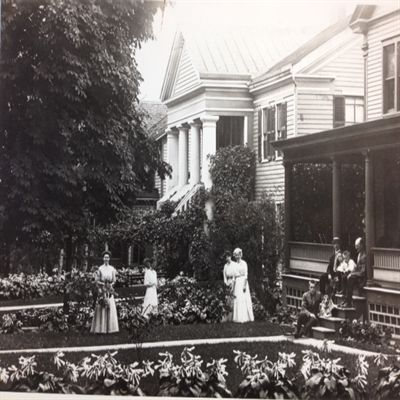Village History
A Brief History
Fayetteville has been the center of trade and business since the first settlers arrived in 1792. "A thriving and beautiful village" was the way the New York Tribune described it in 1876 at the height of the trade generated by the Erie Canal.
The name "Fayetteville" was chosen to honor the hero of the American Revolution, Marquis de Lafayette. The post office, established in 1818, and the village's incorporation in 1844, made the name official.
Today, the mailing address of "Fayetteville" (13066) extends far beyond the actual village boundaries into the town of Manlius and neighboring DeWitt. Households in this area have the highest education and income levels in Onondaga County.
Fayetteville's earliest industries used water power from Limestone Creek. After 1845, the Ledyard Dyke, a man-made shallow power canal, was a more dependable source. The prosperity of the local quarries, mills, farms, stores, warehouses and canal boats led to the building of many of the Greek Revival style homes that still line Fayetteville's Genesee St. Hill and are part of the Fayetteville Historic District which was entered on the National Register in 1983.
Easy, fast transportation -- first by electric trolley and later by buses and automobiles -- helped make Fayetteville home to commuters who worked in Syracuse offices and at Syracuse University. In the years since World War Two, businesses such a General Electric, Bristol-Myers, Carrier and now the medical centers are the primary work places.
Today, homes fill the farm fields and orchards that once surrounded the village center. In each neighborhood, parks provide play space. The Erie Canal has become a recreational hiking trail and Green Lakes State Park on the eastern edge of the village preserves part of a primeval forest and two unusual lakes that provide year-round enjoyment.
February 14th, 2005
--Barbara S. Rivette, Fayetteville Village Historian
The August Lilies, also known as Hostas, lined the walks of some of the homes along East Genesee Street during late summers about 1900

The Fayetteville Feeder
Our new pedestrian bridge connecting our village park to the canal feeder path and Erie Canal pathways reminds us of days gone by where the Erie Canal gave residents a connection to so much. Click here to read our historian's background of The Fayetteville Feeder, the "Heart of the Village's Prosperity."
Fayetteville News Notes
The School Board of the Village of Fayetteville proposes to buy a tract of land known as Wellwood (on the FM Road) as a recreation center and athletic field as well as the site for future school needs. (The “new” school, now the Fayetteville-Manlius middle school, was built in 1932.)
The move is heartily endorsed by the chamber of commerce and this week, after a tour of the grounds, the League of Women Voters declared “it is an ideal site.” – 1929
A traffic officer with a semaphore* on Genesee Street at Academy Street between 10 a.m. and 1 p.m. on Sundays has been requested. Carelessly parked cars along the curb are preventing pedestrians from a clear view of heavy traffic. Fayetteville clergy are enthusiastic over the plan. – 1929
[At that time the Baptist church was on the northeast corner of Academy and Genesee Streets, the Episcopal and Presbyterian (now United Church) were in their present locations and nearby on Genesee street was the Methodist Church.]
Mill Street (now part of Brooklea Drive) is being paved this summer. Onondaga County will pay for 18 feet and the rest will be paid for by property owners fronting on Mill Street and the Village of Fayetteville. – 1929
The Fayetteville Chamber of Commerce plans to purchase two 32x44-inch oval signs to place at points of entrance to the village along the main highway (Rte 5/Genesee St) announcing to the autoist that the community through which they are now passing is Fayetteville.
The letters will be black on aluminum background saying “The Chamber of Commerce of Fayetteville Welcomes You.”
Chamber members have enlisted the cooperation of the Boys Scouts (Troop 51) to make a survey of street name signs at all intersections. Some are on trees, some on buildings and some on poles. – 1929
August 29, 2013
Barbara S. Rivette, Village Historian
Just Yesterday - 1973
by Barbara S. Rivette, Fayetteville Village Historian
Plans are underway for a drive-in bank and hotel on Genesee Street at Burdick Street and Mott Road (now the Craftsman Inn) across from the proposed Eastgate Mall (now the Towne Center, opened as the Fayetteville Mall in 1974.)
Fayetteville's water system was connected to the Metropolitan Water Board's trunk line for Lake Ontario water at 2 p.m. Tuesday, February 7, 1973. This marked the end of the village's 10 year struggle to find a sufficient water supply in various local wells.
The Eagle Bulletin was printing scores from 25 or 30 local bowling leagues each week.
History showed through the road pavement in April when the old trolley tracks appeared on the corner of Salt Spring and Manlius Streets. The last run of electric trolley between Syracuse and Manlius was October 26, 1931.
Residents are re-activating interest in a a bicycle path between Fayetteville and Manlius. They hope to use the former railroad right of way. About 20 cyclists made a trial run on April 15 and found the route "beautiful" and useable in tis present condition. Adjacent homeowners have previously objected to similar plans.
Fayetteville's Rehabilitation Commission, formed to maintain the village's status as a fine residential community, reported April 16 to village officials on its recent opinion surveys of residents and business operators.
